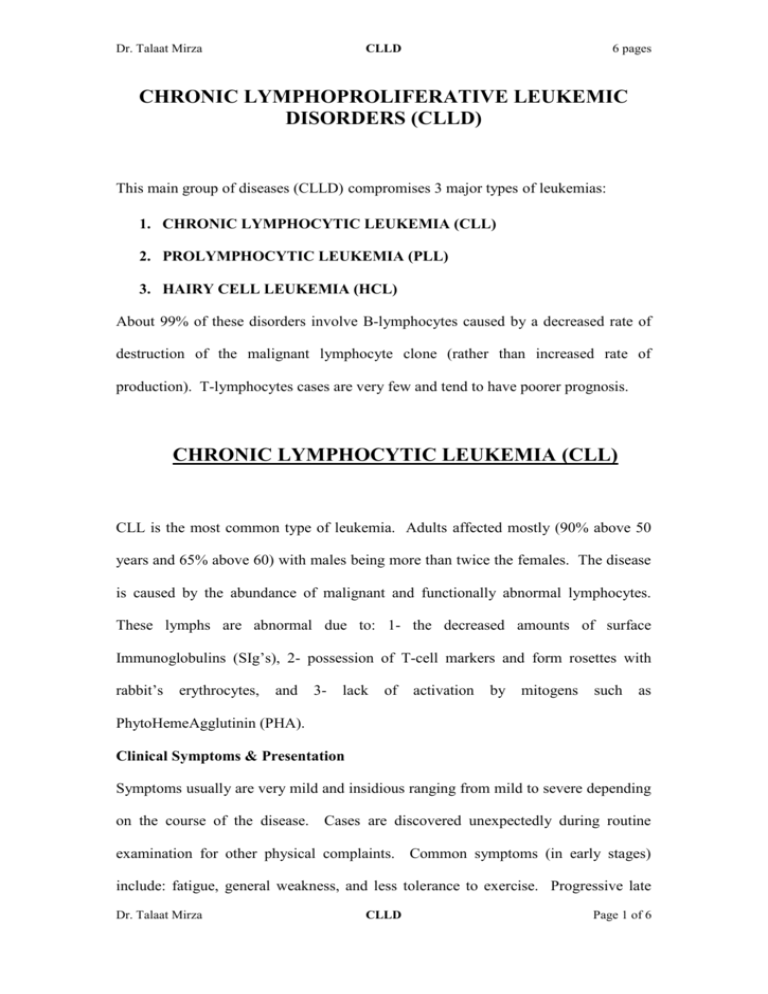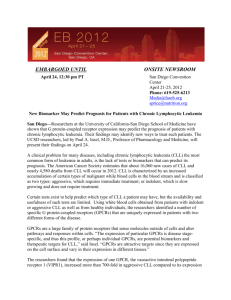chronic lymphoproliferative leukemic disorders (clld)
advertisement

Dr. Talaat Mirza CLLD 6 pages CHRONIC LYMPHOPROLIFERATIVE LEUKEMIC DISORDERS (CLLD) This main group of diseases (CLLD) compromises 3 major types of leukemias: 1. CHRONIC LYMPHOCYTIC LEUKEMIA (CLL) 2. PROLYMPHOCYTIC LEUKEMIA (PLL) 3. HAIRY CELL LEUKEMIA (HCL) About 99% of these disorders involve B-lymphocytes caused by a decreased rate of destruction of the malignant lymphocyte clone (rather than increased rate of production). T-lymphocytes cases are very few and tend to have poorer prognosis. CHRONIC LYMPHOCYTIC LEUKEMIA (CLL) CLL is the most common type of leukemia. Adults affected mostly (90% above 50 years and 65% above 60) with males being more than twice the females. The disease is caused by the abundance of malignant and functionally abnormal lymphocytes. These lymphs are abnormal due to: 1- the decreased amounts of surface Immunoglobulins (SIg’s), 2- possession of T-cell markers and form rosettes with rabbit’s erythrocytes, and 3- lack of activation by mitogens such as PhytoHemeAgglutinin (PHA). Clinical Symptoms & Presentation Symptoms usually are very mild and insidious ranging from mild to severe depending on the course of the disease. Cases are discovered unexpectedly during routine examination for other physical complaints. Common symptoms (in early stages) include: fatigue, general weakness, and less tolerance to exercise. Progressive late Dr. Talaat Mirza CLLD Page 1 of 6 Dr. Talaat Mirza CLLD 6 pages stages of the disease can present with severer symptoms (all of which are caused by the complications of lymph’s replacement of other normal blood cells) such as: pallor, jaundice, fever, easy bruising, weight loss, recurrent infections, bone tenderness, edema, and infiltration of other organs (lymph nodes, liver, kidneys, skin, etc.). About 15% of patients live up to 15 years with little or no treatment, however, the rest (especially with progressive disease) die within a year from diagnosis (median survival rate of 4 years). Similar to CML, the complication of transformation of CLL is possible, where CLL can transform (whether treated or not) to either PLL or Richter Syndrome (a type of large cell lymphoma). However, the classical PLL seen is phenotypically different from the PLL caused by CLL transformation. Lab Findings Although there is an abundance of B-lymph’s (but defective), plasma levels of immunoglobulins (Ig’s) could be quite low, especially in the progressive stage. Due to the increased glycogen in these cells, PAS test is strongly positive. Usually very high WBC counts with absolute lymph’s count ranging from 10150×109/L (up to 1000×109/L, in progressive cases). Early stages neutrophils absolute count might be normal but their differential percentage is decreased. On the other hand, in the late stages there is neutropenia, thrmbocytopenia, and anemia (due to BM hypercellularity with lymph’s). Anemia is also caused by: 1- the increased RBC’s sequestration by the liver, 2- decreased RBC’s survival, and 3AutoImmune Hemolytic Anemia (AIHA), which is a common complication of CLL seen in about 10% of the cases. Dr. Talaat Mirza CLLD Page 2 of 6 Dr. Talaat Mirza CLLD 6 pages Morphology Lymphocytes shape varies from one case to another, but monotonous (constant) within the same patient. In the early stages, cells appear normal yet slightly larger with clumped or condensed chromatin. The N:C ratio is low with 1-2 nucleoli. Cytoplasm is usually abundant (but scant in some cases) with bluish color and no granules. Patients with a progressive disease may have smaller lymph’s with high N:C ratio and clefted nuclei. Usually they are fragile and a lot of smudge cells could be seen in pb smear. BM biopsy or aspiration is not usually needed for diagnosis, but investigations should reveal a hyper-cellular BM infiltrated by more than 30% lymphoid cells. Lymphocytosis could occupy the majority of the BM as the disease progresses. Megaloblastoid features of the erythroid precursors could be seen, indicative of an AIHA presence. Cytogenetics More than 50% of CLL have a genetic defect leading to a poorer prognosis. The most common defects are trisomy 12 (+12) and t (11; 14). Other chromosomes reported to be involved include, 3, 6, 7, 8, and 18. Treatment The 2 goals are to relief and minimize the symptoms, and to prevent further complications. These are achieved by 3 different approaches: 1- Chemotherapy: by using alkylating agent such as Cyclophosphamide whether on its own or in combination with other chemotherapeutic drugs, e.g., Vincristine (a plant alkaloid), or Predonisone (a corticosteroid). Supplemental intra-venous Ig’s could be helpful in fighting infections and the AIHA. Dr. Talaat Mirza CLLD Page 3 of 6 Dr. Talaat Mirza 2- Radiation: CLLD 6 pages Used locally only to treat lymph nodes and spleen in cases unresponsive to chemotherapy. Such treatment would not help in removing the malignant clone but it will free the troubled organs from the malignant cells. 3- Leukapheresis: This is a process where blood is collected from the patient to remove the unwanted WBC (lymph’s, in particular). Then the rest of plasma and RBC’s are re-introduced to the patient. Although, this treatment has no effect on the malignant process (i.e., not a cure), it helps the patient to overcome problems arising from hyper-viscosity (which could lead to heart and kidneys problems). Dr. Talaat Mirza CLLD Page 4 of 6 Dr. Talaat Mirza CLLD 6 pages PROLYMPHOCYTIC LEUKEMIA (PLL) PLL is thought to be a rare variant form of CLL due to some similarities between the two. Similar to CLL, PLL affects adults usually over 60 years old with males more than females. Nevertheless, PLL and CLL have different symptoms and morphology. PLL has the worst prognosis among the 3 CLLD (i.e., worse than CLL and HCL) with a mean survival of 1 year. Symptoms Symptoms tend appear suddenly (acute) and faster than CLL. The most common finding is the accumulation of lymphoid cells (abnormal prolymphocytes) in spleen, BM, and to a lesser extent, the liver. Usually, there is an enormous enlargement of the spleen (and to a lesser extent the liver) with no involvement of the lymph nodes. Lab findings High WBC counts (25-1000×109/L) with low, normal, or high differential of neutrophils and monocytes with some nucleated RBC’s (nRBC’s) seen in pb smears. The malignant cell is a large lymphocyte with round or oval nucleus of coarse chromatin, having 1-2 prominent vesicular nucleoli. Cytoplasm is of bluish color and usually contains no granules. BM shows replacement of normal cells by the malignant clone. Phenotypically, there is an increase in SIg’s with low rosette formation and decreased CD5 expression. Genetics Although it is a quite rare disease (less than 100 cases world wide), about 50% of the cases showed some genetic translocation, involving chromosome 14. Dr. Talaat Mirza CLLD Page 5 of 6 Dr. Talaat Mirza CLLD 6 pages HAIRY CELL LEUKEMIA (HCL) HCL is a very rare disease accounting for 2% of leukemia. Similar to CLL and PLL, HCL is also an adult disease, striking patients over 50 years old with males 5 times more than females. The mean survival rate is 5 years from diagnosis. Death occurs due to complications arising from the infiltration of leukemic cells to BM, spleen, liver, pb, etc. Lab findings 90% of cases showed the presence of the hairy cell in pb. The characteristic hairy cell rarely constitutes more than 50% of the pb differential. The cell is a large lymphocyte with round or oval nucleus containing lacy or loose chromatin. 1-2 nucleoli could be present. N:C ratio is variable but usually low. The cytoplasm is grayish blue in color with no granules, but possessing HAIR-like projections (distinctive feature of HCL cells). There is an obvious pancytopenia in pb which is supported by the replacement of normal marrow cells by the malignant cells (to an extent that sample obtaining is difficult, or what is known as “Dry-Tap” BM). These cells could be differentially diagnosed by staining them with tartrate-resistant acid phosphatase. Only HCL cells are positive while all other leukemias are negative. Treatment Asymptomatic patients are left untreated while splenctomy is a choice of treatment for patients with major splenomegaly (to lower the effect of sequestration of the spleen on RBC and other WBC). Dr. Talaat Mirza CLLD Page 6 of 6








